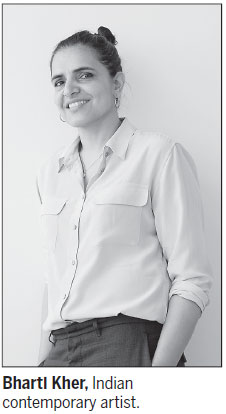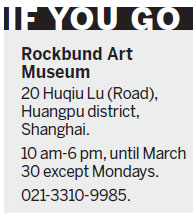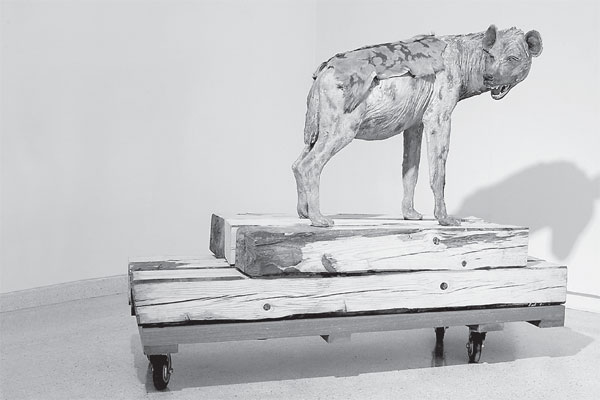Decorative dots speak volumes
Updated: 2014-02-23 06:48
By Wu Ni(China Daily)
|
|||||||
|
The fiberglass hyena sculpture shares its name with that of the exhibition, Misdemeanours. Wu Ni / China Daily |
The iconic bindi is an important facet of traditional Indian culture from which artist Bharti Kher draws inspiration for her creations, writes Wu Ni in Shanghai.
About 20 artworks by Indian contemporary artist Bharti Kher are being exhibited across six floors of the Shanghai Rockbund Art Museum.
Kher was born in the United Kingdom, as the daughter of Indian immigrants. After obtaining her art education in Britain, Kher moved to India in her 20s, where she was greatly influenced by the religions, myths and culture of her home country. Now, the 45-year-old artist lives in New Delhi with her Indian husband, who is also an artist.
Kher has drawn inspiration from traditional Indian culture in her creations. And the bindi, the popular forehead decoration worn by women in India, has become the most significant element in her works, including paintings, sculptures and installations. 
The most outstanding installation is the one hung on the north facade of the museum building. Entitled Target Queen, 16 giant colorful bindis, each measuring about 4 meters in diameter, with overlapping, receding circles akin to a number of giant targets, are installed on the wall.
"It serves as a conceptual and physical 'skin' that encases the museum's monumental facade," says the curator Sandhini Poddar, a Mumbai-based art historian.
From being an outsider in Britain to being an outsider in India, Kher's works have always revolved around the difficult tensions of identity.
Images of animals and hybrid creatures are frequent themes in Kher's works. On the entrance of the Bund-side museum stands a ferocious hyena sculpture made out of fiberglass, with a piece of fur on its back.
One would feel uneasy at the gaze of the hyena sculpture, which shares its name with the name of the exhibition Misdemeanours wondering about the meaning the artist wants to express. "Misdemeanours" indicates the tendency of her artistic creations not letting others see what they expect to see and focusing on what is behind, around and invisible to the naked eye, according to the introduction of the show.
On the second floor, one encounters the heaviest work of the exhibition, a 10-ton cube made up of 131 abandoned radiators. Kher collected these radiators in the United States and sent them to Delhi. After conducting several experiments with them, she finally decided to allow the material to speak for itself exhibiting its original form in the simplest and most direct way, and letting viewers digest it in their own ways.
The giant cube has a beautiful name, The Hot Winds that Blow from the West, as if the visitors could feel the heat the radiators had produced.
"Kher often spends a long time standing in front of the works she creates until she gets the right name. All her works have beautiful and appropriate names," says Stella Wang, who works in the Rockbund Art Museum.
Another striking giant work is The Skin Speaks a Language Not Its Own, which is a giant dying elephant sculpture covered by numerous sperm-shaped bindis, like a skin for the elephant. 
In 1995 Kher was struck by a woman in a market wearing a sperm-shaped bindi. She asked the woman who confirmed that it was sold in the market. She bought all the sperm-shaped, or actually serpent-shaped, bindis in the store and has since then made them a key signature of her works.
The elephant and bindi are both symbols of India. The sperm-shaped bindi is a male symbol with a feminine subject, a strong inquiry into gender issues in the country and beyond. The sperm-shaped bindi on the forehead of the elephant is also a symbol of life that may suggest it is aiding in the recovery of the vast creature when it is in fatal condition.
"Kher's works usually have so many symbols and contradictions that there are a lot of interpretations of her pieces," Wang says.
Contact the writer at wuni@chinadaily.com.cn.
(China Daily 02/23/2014 page9)
